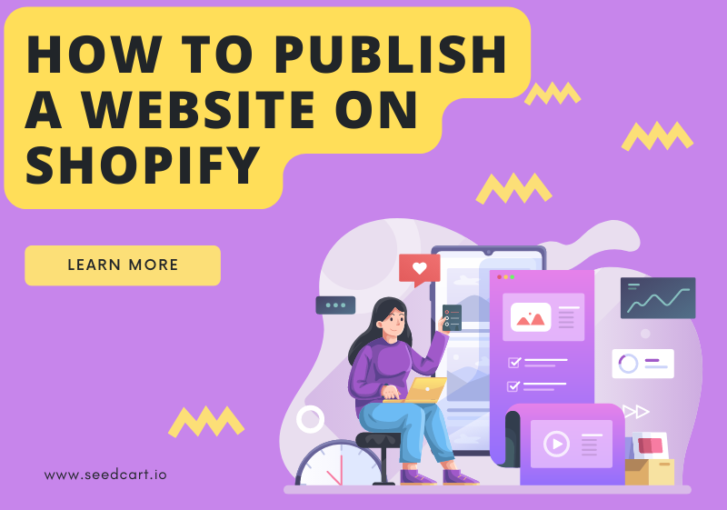When it comes to beginning an online business, the first question most entrepreneurs have is which e-commerce platform to use. If you’re starting a new online business or expanding your physical store into the e-commerce sector, Shopify can help you achieve your goals with plug-and-play solutions that best suit your needs. Shopify is a web platform that gives you all of the tools you need to start selling your products online. From marketing tools to inventory management and everything in between, Shopify has it all.
So, how does Shopify function, and why is it the preferred platform for so many eCommerce businesses? Let’s see if we can figure out what these questions mean and find the answers.
What is Shopify? How does it work?
Shopify is an eCommerce software that allows you to build an excellent store on the internet. It enables you to sell both online and in-person through your own website. From novices to eCommerce pros, this eCommerce website builder offers something for everyone. You may use Shopify to build your own e-commerce website, which you can use to promote your items, generate sales, evaluate marketing stats, manage orders/shipping/payments, and just about anything else. The most challenging component of having an online store is processing payments. Thus, Shopify Plus developers the website, shopping cart, payment, and inventory to all sync up smoothly with no hassles and function together seamlessly.
Shopify includes everything you’ll need to get started with your online business. You’ll need to set up a storefront, display things, connect with customers, handle payments, and more when you start selling online. Shopify provides all of the tools you’ll need to stay on top of all of these responsibilities. Consider Shopify’s platform as a facilitator that makes selling things online easier.
Is Shopify best suited for your requirements?
Shopify is one of the world’s largest and most well-known e-commerce platforms. Shopify is a great option if you’re already selling in person and want to increase your reach by selling online. Shopify provides you greater control over your shop, enables you to use superior marketing and sales tools, and is a key step in expanding your company. Shopify is ideal for small, medium, and big businesses, with Shopify Plus catering to larger, more established businesses.
Shopify is a great option for businesses that want to open an online store or convert an existing physical store to an online one. It’s a complete solution that lets you offer a wide range of products, including fashion, jewelry, electronics, food, and home goods, while also tailoring to your individual requirements. It also relieves you of the headaches of running an online business, enabling you to concentrate on marketing, customer service, and administration.
Shopify for expanding your online business
Shopify provides merchants with some of the most innovative and essential features, such as social network integration and SEO-friendly features such as customized headlines, titles, and meta tags, so that your store may rank well in search results. Customers may provide SEO-friendly product reviews, which help a company’s trustworthiness.
Advantages of Using Shopify
Customer Service is available throughout the week
Shopify provides excellent customer service via email, live chat, and phone. It includes a large library of FAQs that might assist you with technical issues. Its staff of trained representatives is available to give you with prompt and helpful assistance at any time.
Platform with a lot of flexibility
Shopify provides a multitude of features for inventory management, customer support, marketing, shipping, reporting, social media, and much more once you’ve built your online store. Because it is such a versatile platform, you may pick and choose the technologies you need to automate your e-commerce operation.
Services that are completely free
You’ll almost certainly need to pay for a theme if you’re creating a new website. On the other hand, Shopify instantly loads a free theme onto your store, which you can begin customizing in any manner you want. This is why Shopify is perfect for novices who want to learn by doing. You may use free fonts, adjust the color scheme, and upload your own photographs, among other things.
Minimal Entry Barriers
A Shopify store may be started by anybody. Shopify is at the forefront of efforts to remove eCommerce hurdles. When you compare Shopify to other platforms, it’s easy to see why thousands of businesses choose it every year.
Beautiful themes
Shopify’s Theme Store has a selection of professionally designed responsive themes (both free and premium) that may help you optimize your website for a variety of sectors, including clothes, jewelry, and art.
Extremely Fast and Secure
Shopify guarantees that your online business runs smoothly by ensuring that it runs at lightning speed and has a high degree of security, as credit card processing is the most common payment method.
Countless Apps
In the Shopify App Store, there’s a specific application available for basically every need that might surface. Countdown clocks, image background removers, product sourcing applications, and much more are all available. There are a lot of premium applications in the store, but there are also a lot of free apps.
Which Items Can You Sell on Shopify?
There are constantly new popular items available on Shopify that you can sell. Everything is for sale, from fashion to beauty to home and garden. Here are some popular items you might want to try selling:
- Baggage and handbags
- Kitchen appliances
- Accessorize your home
- Apparel
- Products for women’s beauty
- Jewelry
- Accessorize your workout
Shopify, on the other hand, has some stringent rules on what you can and can’t sell. You risk being kicked off the platform if you offer banned items. Essentially, if it’s unlawful or controlled, you won’t be able to sell it on Shopify. When obtaining products for their store’s inventory, people new to online selling should be aware of how to avoid counterfeit goods.
Establishing a Shopify store
Setting up a Shopify store is uncomplicated and straightforward; you can do all of them within an hour, assuming you move slowly and thoroughly verify everything. Don’t worry if you believe you made a mistake since you have a 14-day free trial.
Choosing a name for your business
You must have a unique name before creating a store. Otherwise, Shopify will prompt you to select something different. However, it’s not challenging to come up with a unique name that hasn’t been used before. In fact, Shopify has a free tool called Business name generator that might assist you.
Creating an account
Now go to Shopify and fill out the signup form to get started. This would need a few things. When you’re asked whether you have any items and what you want to sell, you’ll also have to respond. Click “I’m done” once you’ve finished all of those steps.
Pick a theme
You’ll be led straight to your shop admin page after you’ve signed up. You can now begin personalizing your store, setting up payments, uploading items, and sending things to consumers.
Store configurations
You won’t wind up with a website that appears like a clone of any other business because all Shopify themes allow you to make easy tweaks that may drastically alter the design of your store.
Add products
Last but not least, before going live, you must add some things to your store. Select Products from your store’s dashboard page. When you’ve uploaded any items, you’ll see an Add product button in the middle of the page or the top right corner.
Steps to launch or publish your Shopify store
You’ve put in a lot of time and work into creating a Shopify store you’re proud of, importing all of your items, and preparing all of the appropriate legal documentation. It’s now time to put the finishing touches on your Shopify store and launch it.
Here are the steps you’ll need to take to start your online store with Shopify:
Choose a domain name and add it to your website
To get your site up and running, you’ll need to pick a domain name, which is an internet address that your consumers can use to find you. Shopify can also help you obtain a domain name for your business. This will then be added to your store seamlessly. If you are new to the concept of website hosting, this provision help to save a significant amount of your time. Likewise, if you don’t know how to host a website, purchasing a domain from Shopify may save you a lot of time and effort.
DNS records should be updated
You must now change your DNS records if you use a third-party domain provider. DNS is the abbreviation for Domain Name System. It is a technique that merges a domain name with a specific IP address. Because your hosting and domain providers are different, you’ll need to update this.
Erase any passwords from the storefront
If Shopify has password-protected your shop theme, ensure sure the password is deactivated before launching. As amusing as it may appear, you’d be shocked at how quickly people forget about it. It’s much simpler to miss this if you’re the shop administrator because you can access your Shopify store as long as you’re signed in. Even if you don’t remember turning this feature on, it’s worth double-checking a few minutes. If you continue to use your passwords, Shopify will send you a notification so you can immediately use the password deactivate option.
Create the main domain
When you first set up your store, you will be given a default subdomain under the myshopify.com domain. Although you may still use this address to access your site, a custom domain name will give your shop a much more professional appearance. There are also some SEO advantages. Shopify’s management panel allows you to register a domain at a reasonable fee. It’s also simple to do so; these options may be found in the Domains section of the Online Store menu. You can choose a primary domain if you have more than two. This choice informs the search engine of the specific web URL where your Shopify store is situated, avoiding further misunderstandings.
If further domains are required, add them
Steps 1 and 2 can be replicated for as many domains as needed for the business. The principal domain will automatically redirect all other domain names. With the option to Set as primary next to each domain name, you may modify this configuration at any moment. It would help if you kept in mind that the amount of domain names you add to your store has no impact on the SEO of your site.
Your service is up and running!
Congratulations if you were able to complete all of the stages listed above. You should now have a completely functioning and operational Shopify web store. Of course, you can still adjust any segment of your store using the admin backend dashboard, so don’t worry if you’re not pleased with something.
That’s not all; we also have some helpful hints for starting your own Shopify store.
Some further suggestions for launching a Shopify store
You’re definitely itching to get your business up and running, but take your time and double-check everything before going live to ensure everything runs well. And these are the things you should keep in mind while setting up your new Shopify store.
Make sure your title and meta tags are correct
Shopify will fill up the meta description tags and titles for you based on your product description and names by default. However, considering how these tags might affect search engine optimization, you should pay special attention to them.
Make a trial order
You may ensure that your store’s operating procedure settings are proper by placing a test order. You may accomplish this by utilizing Shopify’s Bogus Gateway to test a transaction. This is a free service; however, keep in mind that you must cancel and return the purchase precisely as you placed it.
Check your email address and notification settings
Check that you can get notifications when clients place orders on your Shopify site before going live. You should set up one or more notifications to ensure that no online orders go unnoticed. You might provide your own email address or the email address of another trustworthy employee.
Prepare email subscription forms
If your Shopify theme has built-in email registration forms, double-check that you’ve correctly connected them to your email marketing provider, whether it’s an external service or one integrated within Shopify. You won’t want to miss out on the chance to gather email addresses from visitors or customers, especially because email may drive a lot of traffic to your site.
Cheers on the launch of your Shopify store!
That’s all; now press the publish button to open your Shopify store, and it’s ready to connect with the rest of the world. But this is only the beginning; you still have a long way to go before you can generate sales or take care of your clients.


